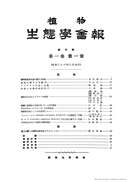最新号
選択された号の論文の28件中1~28を表示しています
- |<
- <
- 1
- >
- >|
-
原稿種別: 表紙
1954 年 3 巻 4 号 p. Cover1-
発行日: 1954/06/30
公開日: 2017/08/10
PDF形式でダウンロード (59K) -
原稿種別: 表紙
1954 年 3 巻 4 号 p. Cover2-
発行日: 1954/06/30
公開日: 2017/08/10
PDF形式でダウンロード (59K) -
原稿種別: 付録等
1954 年 3 巻 4 号 p. App1-
発行日: 1954/06/30
公開日: 2017/08/10
PDF形式でダウンロード (89K) -
原稿種別: 本文
1954 年 3 巻 4 号 p. 143-152
発行日: 1954/06/30
公開日: 2017/08/10
PDF形式でダウンロード (955K) -
原稿種別: 本文
1954 年 3 巻 4 号 p. 153-157
発行日: 1954/06/30
公開日: 2017/08/10
PDF形式でダウンロード (541K) -
原稿種別: 本文
1954 年 3 巻 4 号 p. 158-161
発行日: 1954/06/30
公開日: 2017/08/10
PDF形式でダウンロード (380K) -
原稿種別: 本文
1954 年 3 巻 4 号 p. 162-166
発行日: 1954/06/30
公開日: 2017/08/10
PDF形式でダウンロード (517K) -
原稿種別: 本文
1954 年 3 巻 4 号 p. 167-173
発行日: 1954/06/30
公開日: 2017/08/10
PDF形式でダウンロード (751K) -
原稿種別: 本文
1954 年 3 巻 4 号 p. 174-179
発行日: 1954/06/30
公開日: 2017/08/10
PDF形式でダウンロード (619K) -
原稿種別: 本文
1954 年 3 巻 4 号 p. 180-185
発行日: 1954/06/30
公開日: 2017/08/10
PDF形式でダウンロード (555K) -
原稿種別: 本文
1954 年 3 巻 4 号 p. 186-192
発行日: 1954/06/30
公開日: 2017/08/10
PDF形式でダウンロード (669K) -
原稿種別: 本文
1954 年 3 巻 4 号 p. 193-202
発行日: 1954/06/30
公開日: 2017/08/10
PDF形式でダウンロード (1061K) -
原稿種別: 本文
1954 年 3 巻 4 号 p. 203-210
発行日: 1954/06/30
公開日: 2017/08/10
PDF形式でダウンロード (834K) -
原稿種別: 本文
1954 年 3 巻 4 号 p. 211-218
発行日: 1954/06/30
公開日: 2017/08/10
PDF形式でダウンロード (836K) -
原稿種別: 本文
1954 年 3 巻 4 号 p. 219-229
発行日: 1954/06/30
公開日: 2017/08/10
PDF形式でダウンロード (1823K) -
原稿種別: 本文
1954 年 3 巻 4 号 p. 230-235
発行日: 1954/06/30
公開日: 2017/08/10
PDF形式でダウンロード (631K) -
原稿種別: 本文
1954 年 3 巻 4 号 p. 236-249
発行日: 1954/06/30
公開日: 2017/08/10
PDF形式でダウンロード (1061K) -
原稿種別: 本文
1954 年 3 巻 4 号 p. 250-270
発行日: 1954/06/30
公開日: 2017/08/10
PDF形式でダウンロード (1506K) -
原稿種別: 本文
1954 年 3 巻 4 号 p. 271-276
発行日: 1954/06/30
公開日: 2017/08/10
PDF形式でダウンロード (816K) -
原稿種別: 本文
1954 年 3 巻 4 号 p. 277-281
発行日: 1954/06/30
公開日: 2017/08/10
PDF形式でダウンロード (562K) -
原稿種別: 本文
1954 年 3 巻 4 号 p. 282-289
発行日: 1954/06/30
公開日: 2017/08/10
PDF形式でダウンロード (1083K) -
原稿種別: 本文
1954 年 3 巻 4 号 p. 290-294
発行日: 1954/06/30
公開日: 2017/08/10
PDF形式でダウンロード (542K) -
原稿種別: 本文
1954 年 3 巻 4 号 p. 295-301
発行日: 1954/06/30
公開日: 2017/08/10
PDF形式でダウンロード (1429K) -
原稿種別: 本文
1954 年 3 巻 4 号 p. 302-
発行日: 1954/06/30
公開日: 2017/08/10
PDF形式でダウンロード (158K) -
原稿種別: 本文
1954 年 3 巻 4 号 p. 303-304
発行日: 1954/06/30
公開日: 2017/08/10
PDF形式でダウンロード (235K) -
原稿種別: 付録等
1954 年 3 巻 4 号 p. App2-
発行日: 1954/06/30
公開日: 2017/08/10
PDF形式でダウンロード (37K) -
原稿種別: 表紙
1954 年 3 巻 4 号 p. Cover3-
発行日: 1954/06/30
公開日: 2017/08/10
PDF形式でダウンロード (68K) -
原稿種別: 表紙
1954 年 3 巻 4 号 p. Cover4-
発行日: 1954/06/30
公開日: 2017/08/10
PDF形式でダウンロード (68K)
- |<
- <
- 1
- >
- >|
